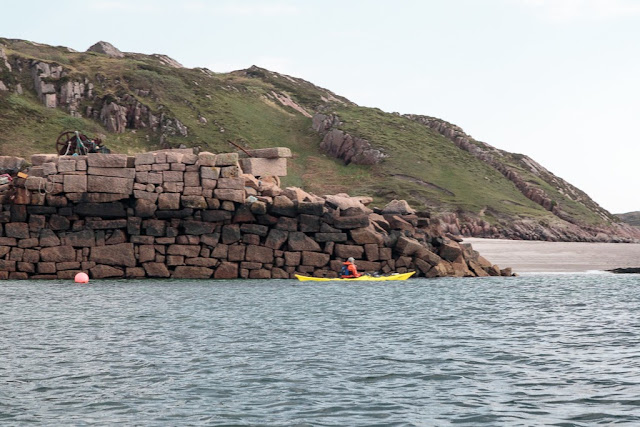On our return from Market Bay on the north coast of the Ross of Mull the wind got up and in truth it was a bit of hard work to get back into the shelter of...
...
the islands at the north end of the Sound of Iona. From here we entered...
...
the Bull's Hole a safe but tidal anchorage between the Ross of Mull on the left and Eilean nam Ban on the right. Today the Bull's Hole is the anchorage for many of the tour boats which operate from the Sound of Mull to Staffa and the Treshnish Isles.
Donald had waited for us on a little beach at the NE of the rocky Eilean nam Ban. Although St. Columba was beatified by the church he was not exactly a saint in terms of modern understanding of the word. Not only had he caused the death of death of 3,000 people (men) after starting the Battle of Cúl Dreimhne he fled to Iona then banished all cows (and women) to this barren and rocky isle.
The Bull's Hole can be quite a brisk paddle if the tide is running strongly but we only had a slight current to contend with and soon arrived at
Tormore Pier at the south end of the Hole. It was here that blocks of pink Ross of Mull granite were exported to build parts of Iona Abbey, University of Glasgow, Ardnamurchan, Heskier. Skerryvore and Dubh Artach lighthouses, the Jamaica and Kirklee bridges in Glasgow and Blackfriars, Holburn Viaduct and Westminster bridges in London, docks in Glasgow Liverpool and New York not to mention buildings and monuments further afield in New Zealand and USA. A tramway leads up from the pier to the quarry at Torr Mor.
Above Alan's head at the base of some low cliffs you can see the dark opening of
Uamh nan Marbh, the cave of the dead, where coffins were left before final transport to Iona for burial. The cave is really only big enough for one coffin and has a ventilation window at the back.This was probably quite important as corpses were brought here from all over Scotland and some would undoubtedly be in an advanced state of decomposition by the time they got here.
Due to the fresh N wind and the building N going tide in the Sound of Iona we decided to leave exploring the Abbey until the following morning but Donald nipped across the Sound of Iona in his F-RIB as we...
...continued south to Fionnphort and the ferry terminal. The ferry MV Loch Buie was just about to leave and had already lifted its ramp when two young women tottering on high heels and pulling heavy suitcases on wheels made their way slowly down the slip. The captain clearly thought more of women than St. Columba and lowered the ramp while they sauntered (rather too slowly I thought) down the slipway. Ian gave the captain a quick call on the VHF and he replied that we had plenty of time to cross in front of him before he left.
From Fionnphort to Fidden the coastline consists of a delightful series of pink granite tors and offshore islands and reefs. Alan enjoyed a try of my Greenland paddle and...
...before long we could see Fidden farm at the end of our long day.





















































